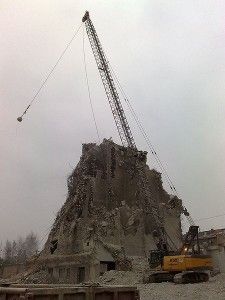Redevelopment is Prop. 13 in Reverse

by WAYNE LUSVARDI
To California redevelopment advocates, the policy brings the Midas touch to cities, turning everything into gold for the Golden State. Redevelopment fans point to all the beautiful new malls, restored Old Town business districts, industrial parks and mixed-use developments with trendy condos and apartments as self-evident proof that King Midas has visited them.
To cash-strapped cities, redevelopment has been a purported savior. Taking it away, as proposed by Gov. Jerry Brown and the state legislature, is perceived as stabbing King Midas’ hand.
But why would so many liberal, Democratic legislators vote to end redevelopment if it truly gave cities the power of the Midas touch? Because it robs public schools and public services of about $1.7 billion in revenues each year that have to be backfilled with other funds. Redevelopment is like the lyrics to the Hollies British pop and rock group song “King Midas In Reverse”:
“I’m not the guy to run with ‘cause,
“I’ll throw you off the line
“I’ll break you and destroy you given time”
He’s King Midas with a curse,
He’s King Midas in reverse
All he touches turns to dust
All he touches turns to dust
Reversing Prop. 13
But there is another underside to redevelopment that is rarely, if ever, discussed. Not only does redevelopment rob schools and first-responder services of revenues, it subverts California’s Proposition 13, the tax-limitation measure passed in 1978. Behind the more than 400 glossy redevelopment agency websites in California marketing the advantages of redevelopment with photos of beautiful new real estate developments is the reality that redevelopment neutralizes Prop 13. Redevelopment condemns properties with low tax revenues, then up-zones them to achieve a higher property and sales tax base.
Redevelopment proponents say that Prop. 13 is the cause of the expansion of redevelopment in California and the cause of the lack of revenue to balance the state budget. No. It isn’t Prop. 13 itself, but the irrefutable reaction to Prop 13 — the expansion of redevelopment — that has caused a $1.7 billion hole in the state budget. Otherwise, why would state officials vote to repeal redevelopment?
Banking on Blight
According to a 1999 report, “Banking on Blight,” the City of Long Beach had 54 percent of its land area within designated redevelopment project areas. The City of Lancaster had 49 percent, Compton 40 percent and Burbank 17 percent.
The percentage of the property value of redevelopment areas of all city properties was 46 percent for Lancaster, 32 percent for Compton, 19 percent for Burbank and 17 percent for Long Beach. The City of Lancaster had a whopping 27,702 acres — more than 43 square miles — under redevelopment. In the City of Long Beach, 17,153 acres — more than 26 square miles — was so designated.
| City | Agency Established | Percent of Value of All City Properties | Number of Project Areas | Total Acres | Percent of City Land in Redevelopment |
| Burbank | 1970 | 19 percent | 4 | 1,908 | 17 percent |
| Compton | 1967 | 32 percent | 1 | 2,635 | 40 percent |
| Lancaster | 1979 | 46 percent | 7 | 27,702 | 49 percent |
| Long Beach | 1961 | 15 percent | 8 | 17,153 | 54 percent |
.
As of June 30, 2010, the net “assets” of the Redevelopment Agency of the City of Lancaster were a whopping $218,101,533 in the red! That’s what they owed. (Inside the link, download the June 30, 2010 document. The number is on page 6.) That happened even as the The Lancaster School District was closing old school facilities amid declining attendance and trying to plug a $12 million budget deficit as of March 2010. As the song says, “All he touches turns to dust.”
The City of Compton has a $25 million general-fund budget deficit out of a total $58 billion budget and no reserves, as of 2011. The Compton School District has been facing budget shortfalls since the 1990’s, despite forming its redevelopment agency in 1967. Again, “All he touches turns to dust.”
The City of Burbank has a balanced budget as of 2011, but this is mainly due to an economic base in the entertainment and media industry, a regional airport and lack of reliance on new auto sales, which fluctuate. “All he touches turns to dust.”
The City of Long Beach is facing an $18.5 million budget deficit and rotating fire station closures. The Long Beach School District is facing $60 million in budget cuts. “All he touches turns to dust.”
It’s clear that the latent or covert function of redevelopment in California is to undo the property tax reassessment protections of Prop 13.
The remainder of the lyrics to “King Midas in Reverse” put it well:
It’s plain to see it’s hopeless
Going on the way we are
So even though I’d lose you
You’d be better off by far
He’s not the man to hold your trust
Everything he touches turns to dust
In his hands
Nothing he can do is right
He’d even like to sleep at night
But he can’t
All he touches turns to dust
All he touches turns to dust
All he touches turns to dust
All he touches turns to dust
I wish someone would find me
And help me gain control
Before I lose my reason
And my soul
Here’s a YouTube of the song:
Related Articles
U.S.-Calif. Stuck in Stagnation Spiral
JULY 26, 2011 BY JOHN SEILER Welcome to the desert of economic and jobs growth. I keep reminding people that
Water workshop finds only ‘miracle’ can end drought
IRVINE — “Dismal, poor, horrible, abysmal” are the current snowpack and water runoff conditions in California, according to Jeanine Jones, the




